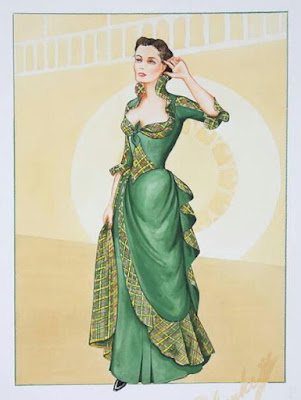Originally published on the
Coletterie blog.
Orry Kelly (1897-1964) Australian
 |
| Ava Gardner in One Touch of Venus, 1948. |
Orry-Kelly was considered one of the top three costume designers in the 1930s alongside Travis Banton and Adrian. Before being hired by Warner Brothers in 1932, he had designed costumes for Broadway actresses. During his career in films, he dressed numerous studio stars such as Barbara Stanwyck, Bette Davis, Kay Francis, Ingrid Bergman, and Rosalind Russell.
 |
| Actress Kay Francis wearing in Orry-Kelly. |
Born John Orry Kelly, he grew up in Australia with his Irish parents. In 1923, he immigrated to New York hoping to be a Broadway star. He worked a variety of jobs, including a successful stint as a mural painter. He also designed for vaudeville as well and more highbrow theater. Originally hired to design theater sets, he was offered a job at Fox in their New York studio art department.
 |
| Actress Dolores Del Rio. |
Once in Hollywood, he was hired by First National Films (later owned by Warner Brothers) and soon changed his name to Orry-Kelly. On his first film there,
The Rich Are Always With Us (1932) he began his long and successful working relationship with Bette Davis. Orry-Kelly was known as the one designer who could satisfy and flatter her figure and personality. He specially designed corsets and brassieres to mold Davis’ figure for period film roles. However, for modern-set films, she refused to wear these types of supportive garments. Instead, Orry-Kelly relied on cleverly cut, well made garments and when dressed by him, Davis seemed elegant and at ease.
 |
| Actress Glenda Farrell, 1933. |
Orry-Kelly also took historical accuracy more seriously than most of his peers in the shape and scale of the decorative trimmings he used on his costumes. He bridged the gap between realism and the exaggeration needed in movies.
 |
| Bette Davis in Jezebel, 1938. |
Before color film, black and white films had to suggest colors by using various shades of gray. In reality, the costumes would sometimes be constructed in bizarre color combinations such as lavender and orange or magenta and lemon yellow in order to represent what was desired on screen. In
Jezebel, the famous red dress that Bette Davis wears; when created out of bright red satin actually looked dull on film. The final dress ended up being rust-brown in color to appear “red” when rendered in black and white. Orry-Kelly was known to have said that his color range consisted of “varying shades of muck.”
 |
| Bette Davis in Dark Victory, 1939. |
He was known for being temperamental and argumentative as a result of his alcoholism. He had been discharged from the Army in 1942 for his drinking. During his time at Warner Brothers he was notorious for arguing with his boss Jack Warner and walking out, returning after a few days. In 1944, he was finally fired from Warner Brothers and worked for 20
th Century Fox until 1947 and from 1950-1964 he freelanced for Fox, Metro-Goldman-Mayer, and United Artists.
 |
| Marilyn Monroe in Some Like It Hot, 1959. |
His films: Jezebel (1938),
Dark Victory (1939),
The Little Foxes (1941),
Casablanca (1942),
Now Voyager (1942),
Some Like it Hot (1959),
Baby Face (1933),
Auntie Mame (1958),
Irma La Douce (1963), and
An American in Paris (1950), and
Oklahoma (1955).
His style, innovations, and influence on fashion:
 |
| Gene Kelly and Leslie Caron, 1951. |
 |
| Mame, 1958. |
- He designed Rosalind Russell’s fabulous, ever-changing wardrobe for the 1958 screen version of Auntie Mame.
- Orry-Kelly covered his salon reception room with expensive silver leaf and requested a portable bar on wheels for himself and his guests.
Sources: In a Glamorous Fashion: The Fabulous Years of Hollywood Costume Design (1980) W. Robert La Vine; Adrian: Silver Screen to Custom Label (2008) Christian Esquevin.























































